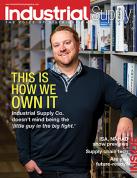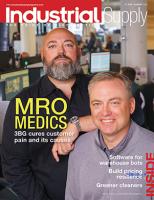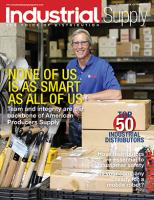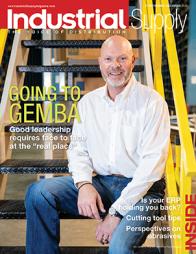Industry Outlook – Three Experts Weigh In on ’25
How to stay agile despite labor shortage, tariffs, and inflation.
By Kim Phelan, Editor
In December, Industrial Supply reached out to three well-known economic and industry experts with an unusual hypothetical question. To Chris Chidzik, principal economist at the Association for Manufacturing Technology, Tim Fiore, chair of the Institute for Supply Management’s Manufacturing Business Survey Committee, and Curtis Dubay, chief economist, economic policy division at the U.S. Chamber of Commerce, we said: “Congratulations – effective January 1, you have inherited an industrial distribution company with seven locations in major metro areas across the country. What are your top immediate business actions as you take the helm?”
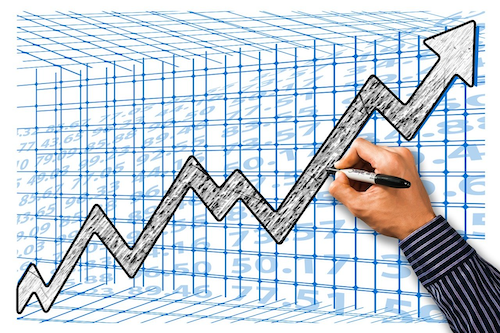
Chidzik responded, “Most forecasts are predicting a large increase in demand for manufacturing technology in 2025, so I would take the helm of this theoretical business with a strategy of taking advantage of that boom. The first thing I would do would be to make sure that I was staffed at the appropriate level and my employees had all of the necessary training. If the predictions hold true, 2025 may look a lot like 2017/2018, so I would look back and see what pain points prevented me from taking more market share back then, what levels of inventory allowed me to keep customers happy without tying down too much capital, and most importantly, talk with my customers to see what their expectations for 2025 will be, how they intend to respond, and what part I can play in helping them prepare.
Fiore had a clear and succinct path: “(1) I would have enough inventory on hand to become the preferred supplier in my markets, (2) I would make sure I had cost stability so I wouldn’t disappoint my customers with volatility in pricing and availability, and (3) I’d make sure my financing is secured for the next four years.
Dubay said he would have just one major focus: “We are going to be short on workers for the rest of my lifetime. I am starting immediately to figure out how to use AI, automation, and mechanization to make our products with fewer workers.
Overall, the three experts concur on a positive macro-economic outlook for 2025. Growth will be stronger than 2024, said Dubay, because of lower interest rates, lower inflation, and less uncertainty with the election outcome decided. He also believes the Fed’s course will be clear and anticipates an additional boost from rising productivity resulting from advancing integration of AI.
The Fed was top of mind for Chidzik, who said, “Conditions are pointing to a high probability the Federal Reserve has pulled off the soft landing they have promised. Going into 2025, the largest risks to the economy are likely exogenous shocks such as escalation of geopolitical tensions, natural disasters interrupting supply chains and impacting commodity prices, or fiscal policy changes that can affect the current path of the economy.
While acknowledging a positive forecast going into ‘25, Fiore nonetheless noted it’s not as positive as lower rates and a friendly administration would indicate. “This may have to do with concern over fiscal and monetary policy clashing at the expense of business,” he said. “We plan for growing revenue at 4.2%, expanding capacity by 4%, CAPEX expansion at 5.2%, headcount growth at 0.8%, labor and benefit costs growth at 3.3%, and price growth at 3%. Hiring will be slow, and investments will be watched closely.”
As they drilled down into the U.S. industrial/manufacturing sector, sources offered less consensus in their assessments of the post-COVID era. Chidzik says the sector is in a very strong position, maintaining strong consumer demand momentum that began during 2020’s COVID shutdowns. “Assuming the economy remains in a good position and consumers continue to demand goods at or above their current level, there will be a lot of opportunity for manufacturers going into 2025,” he said. “In addition to the robust consumer demand, manufacturers have benefitted from increased government spending in various places such as infrastructure investment, defense acquisitions and clean energy projects.”
But Dubay observes that “manufacturing is still re-normalizing to the post-COVID world. The sector was strong during COVID because of the need to buy things instead of services. It has struggled since because people are back to spending on services, and higher interest rates have suppressed demand for bigger-ticket durable goods,” he added. “I see some improvement with lower interest rates, but nowhere near a full rebound to COVID-era highs.
Fiore summed up with a look at the numbers: “We have been contracting for two years,” he said. “We saw less than 1% nominal revenue growth meaning we did not keep up with inflation, we released -1.1% of our headcount, and we are still operating at rates that we have not seen since 2017.
Thoughts on Threats, Opportunities
The U.S. industrial sector will not be immune to a number of potential threats this year. While many policy uncertainties were settled on November 6, sources identified a new set of concerns. Chief among them are (1) the potential return of inflation (and a hard landing, Fiore cautions) and (2) the looming but still-unclear advent of tariffs.
Considering further risks, Chidzik returned to speculation about the Fed, suggesting an unfavorable consequence if they’ve overshot their target and cause a rapid loosening of labor market conditions going into 2025. “While this would definitely have the largest impact on the economy, I think the Federal Reserve is monitoring the situation and adjusting policy in a manner that will maintain the growth path of the economy,” he said.
Dubay points to tariffs and immigration as “far and away the biggest threats” confronting the U.S. and the sector specifically. However, he says lower interest rates have the favorable potential to revive demand and create an economy strong enough to overcome the expected drag of tariffs. Meanwhile, Fiore cautions that, “we are at the lowest point of price pass through. In 2022, our survey said only 28% could not pass price increases through; in December 2023 it was 31%, and in December 2024, 44%. So, sellers do not have leverage, which indicates weak demand.”
All three sources agree that unknowns such as escalating geopolitical tensions and natural disasters pose serious threats to supply chains and the economy at large. According to Fiore, the greatest opportunity the U.S. has to positively impact industrial growth is to disconnect itself from the China supply base. “This will take a lot of time and means new global partners friendly to our views – not just our relationship with Mexico.”
To remain agile and strong in 2025, sources advise industrial distributors to (1) actively use a good source of data by which to measure your market and how your business is performing (Chidzik); (2) figure out how to meet strong demand with fewer workers (Dubay); and (3) because OEMs will want your product when they want it, move quickly back to the just in time environment and be prepared to use your balance sheet to support your customers with inventory they will need. (Fiore).







